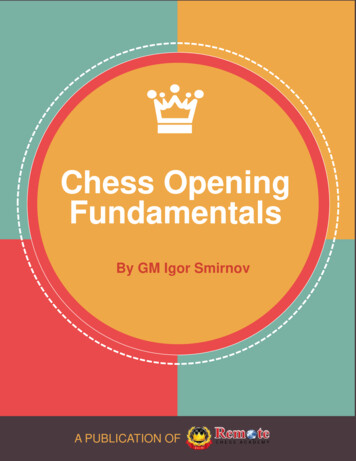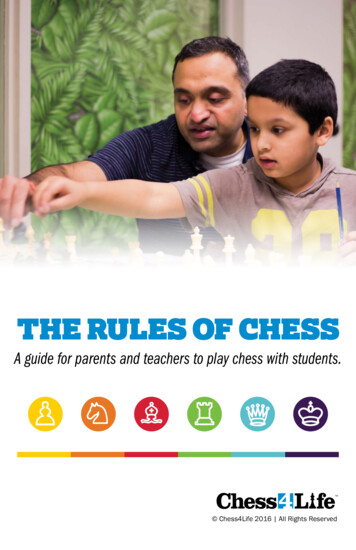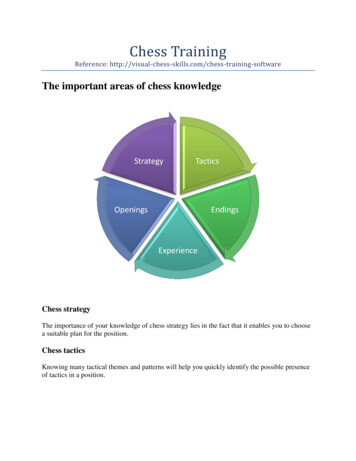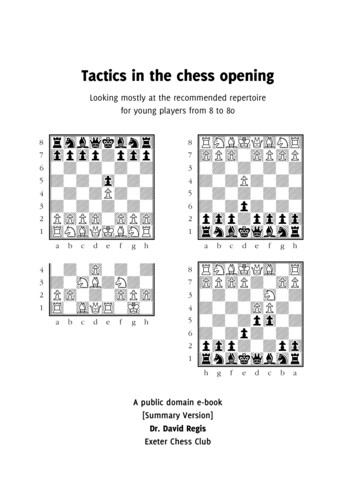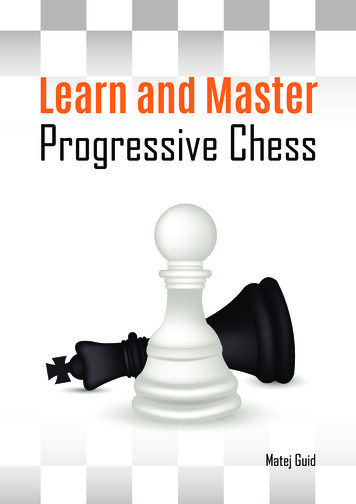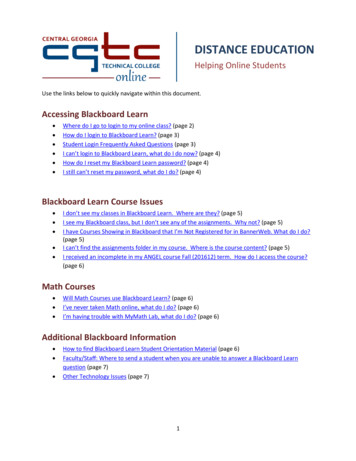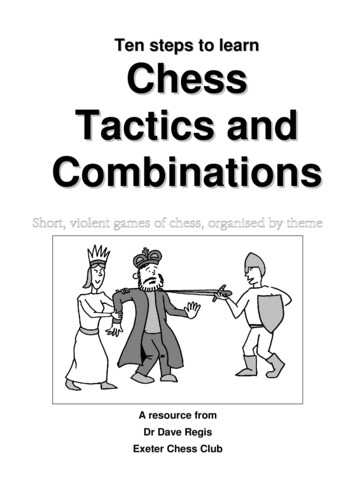
Transcription
Ten steps to learnChessTactics andCombinationsA resource fromDr Dave RegisExeter Chess Club
IntroductionA note for playersHere is a collection of very short games organised by tacticaltheme. The main aim is to give you a quick run-through the basictactical ideas in genuine positions. One advantage of using shortgames is that you can set the positions up on a board veryquickly and accurately. You can of course just use the diagramsas test positions.I have selected as many of the games as possible from openingsystems that are commonly recommended for improving players.This is the great main highway of chess, and the views to eitherside are wonderful.I've marked where I think the losing side could have played betterwith the chessplayer's frown, "?", so you can go over each gameonce again, trying this time to improve the play.DRA note for teachers and coachesAnyone could have done this, and maybe you would have done itbetter, but you might find it useful that it has been done bysomeone else.I find it as easy to play over a short game from the start positionas it is to set up a position from scratch, so when working withplayers over a board I like to use this type of example.Nearly all the games start 1.e4 e5 2.Nf3, which I hope meansthey will connect with, and reinforce, good opening principles forlearner players, and show poor play punished. The exciting mainlines of the Max Lange and Fried Liver Attacks featurethroughout, and Damiano's Defence endures some terriblebeatings. There is an opening index by ECO code so you canrun through several tactical ideas associated with one opening oreven one variation.DR
Contents1The ABC of tactics .82The three most common reasons games are lost.102.1 Take a piece for nothing .102.2 Take a more important piece.112.3 More attackers than defenders .123One-move ideas .133.1 Forks .133.2 Pins and skewers.163.3 Skewers.193.4 Nets .204Two-move ideas and more.234.1 Jumps .234.2 Undermining .294.3 Overloading .304.4 Interference .314.5 Decoy.324.6 Clearance .334.7 Intermezzi and Zwischenzuge.345Combinations.356Counting and calculating .406.1 Defending .436.2 Counterattacking.456.3 From bad to worse .466.4 Traps .487What makes a combination work?.497.1 Checks.497.2 Captures .497.3 Loose pieces.507.4 Unsafe King .508Checkmates.518.1 Checkmating the uncastled King .518.2 Checkmating the castled King .608.3 King hunt .628.4 Longer checkmates .649Lots of ideas at once!.7210Test yourself!. Error! Bookmark not defined.Opening Index.80
How to read and write downchess gamesW ÆÇÈwEach piece is shown with a letter,as follows:Each square is described by alower-case (small) letter (a-h)which names the file, and anumber (1-8) which tells youthe rank. So, the squaremarked with a * is a4.KKKingQQQueenBBBishopNNKnightRRRookEach move tells you which piece has moved to which square.So Rb5 means the White Rook moves to the square b5.Pawn moves are shown without a "P", just the square is named:so d6 means the White Pawn on d5 moves to the square d6.
When you take a piece a cross (x) is used: so Rxb8means the Rook takes the Bishop on b8. If you take with aPawn, you write the file that the Pawn starts on, for example,gxf4.Check is shown with a plus ( ), Rh1 . Checkmate isshown with two plus signs, Qg7 , or a hash, Qg7#.Castling King's-side is shown as O-O; castling Queen'sside is shown as O-O-O (neither shown on the diagram).Sometimes two of the same kind of piece can move to thesame square. For example, both Knights could move to d6. Weshow which Knight we have moved by naming the startingsquare, so N(f5)d6. Most players shorten this to either Nfd6 orN5d6.Three dots before a move (.Rb7) mean it is a move byBlack.Also, sometimes you see a "!" or "?" sign after a move. It'sa quick way of telling you how good the move is.!means a good move!?means a risky move which might turn out well?!means a dodgy move which might turn out badly?means a bad moveDaniel – Gericke [C41]Game information is like this: corr BDF, 1993White was Daniel and Black was Gericke. The opening wasEncyclopaedia of Chess Openings code C41, which is Philidor'sDefence. The game was played by correspondence with theBDF (German Correspondence Chess Federation) during 1993.
1 The ABC of tacticsThe building blocks of combinations are these ideas:Loose wdqDw}White&wdwdwdwd} wDndwDw} 9EFJMVOutnumbered wdRd}%dwdwdwdw}v,./9EFJMV
Ties dwIw}av,./9EFJMVTies wd}5DwDwdwDw}&wdwdwdwd}3D!wDwDwDw}2wdw"dw)P)}%dw!w wIw}av,./9EFJMVJumps (discoveries, }3dwdwdNdw}2wdwdq)P)}% wdwdwIw}v,./9EFJMVIdea .Ne2 !
2 The three most common reasons games are lostThe three most common reasons games are lost betweenlearning players don't have anything to do with all the fancy ideasyou'll see in the rest of the book. They are more like accidentsthan tactical tricks; oversights and carelessness are the cause,not your opponent's clever play.The three most common accidents are:1. You lose a piece for nothing.2. You lose a piece for a less important piece (or a pawn).3. Your piece is outnumbered: there are more attackersthan defenders2.1Take a piece for Dw0wDw}&wDBDPDwD}3DwHwDNDw}2P)PDw)P)}% DwDwDwD}5DwDwDwDw}&wgwDwDwD}3DwHNDwDw}2P)PDB)P)}% wGwIwDR}v,./9EFJMVA free giftDaniel - Gericke [C41]corr BDF, 19931.e4 e5 2.Nf3 d6 3.d4 Nd7?!4.Bc4 h6 5.Nc3 c6 6.dxe5 dxe57.0-0 U DIAGRAMThe simplest idea of all.7.Bd6? 8.Qxd6 Qf6 9.Rd1 1-0A unique opportunityJackson,J - Kozlov,V [C40]corr Atars mem, 19931.e4 e5 2.Nf3 f5 3.Nc3 fxe44.Nxe5 Qf6 5.d4 exd3 6.Nxd3Qe6 7.Qe2 Qxe2 8.Bxe2 Bb4?U Black finds the only move onthe board to lose a piece fornothing.9.Nxb4 1-0
2.2Take a more important )wDw}&wDwDnDwD}3DwDwDNDw}2P)P!w)P)}% 1pDwhwD}5hwDw0wHw}&BDwDwDwD}3Dw)wDwDw}2P)w)wgP)}% NGQ DwD}5DwDwDwDw}&wDw0PDwD}3DwHwDNDw}2P)PDw)P)}% wGQIBDR}v,./9EFJMVBargainSimler,K – Avguarde [C55]Fremont, 19921.e4 e5 2.Nf3 Nc6 3.Bc4 Nf6 4.d4exd4 5.e5 d5 6.Bb5 Ne4 7.Qxd4?Bc5 8.Bxc6 bxc6 9.Qd2? UNot a free gift, but a good swap forBlack.9.Nxd2 0-1ProfitBrown,D - Kirshner,M [C58]Palo Alto, 19921.e4 e5 2.Nf3 Nc6 3.Bc4 Nf6 4.Ng5d5 5.exd5 Na5 6.Bb5 c6 7.dxc6bxc6 8.Ba4 Bc5 9.0-0 Qb6 10.c3Ba6 11.Re1 Bxf2 12.Kh1 UBlack makes a profit on thefollowing exchange: 12.Bxe113.Qxe1 Ng4 14.Qe4 Nf2 0-1ConfusedSlothouber,F – Huitt Jr,P [C41]IECG, Cat-D (m/2947/02), 19951.e4 e5 2.Nf3 d6 3.d4 exd4 4.Nc3?UWhite got the right moves in thewrong order.4.dxc3 5.e5 cxb2 6.Bxb2 f6 7.exf6Nxf6 8.Bc4 Qe7 9.Qe2 Nbd7 10.00 Qxe2 0-1
2.3More attackers than DwDw0wDw}&wDp1NDwD}3DwDwDQDw}2P)P)w)P)}% DpDwDwD}5DwDwHw1w}&wDwDpDwD}3DwDwDwDw}2P)P)w)P)}% DnDwDwD}5DwDw0wHw}&wDBdnDwD}3DwDwDwDw}2P)P)w)P)}% NGQIwDR}v,./9EFJMVEasy as 123Sneiders,E - Grosshans,R [C57]Corr, 19871.e4 e5 2.Nf3 Nc6 3.Bc4 Nf64.Ng5 d5 5.exd5 b5!? 6.dxc6 bxc47.Qe2 Qd5 8.0-0 Bd6 9.Qf3 Qd410.Ne4? U10.Qxe4 0-1Queen takes Knight, Queen takesQueen, Knight takes QueenOutnumberedGrewe,B - Kutzner,S [C55]RL-chJ U15 Mendig, 19941.e4 e5 2.Nf3 Nc6 3.Bc4 Nf64.Nc3?! Nxe4 5.Nxe4 d5 6.Bb5dxe4 7.Nxe5 Qg5 8.Bxc6 bxc6 UWhite needs a safe square for theKnight.9.Ng4? Bxg4 0-1 Not that one!A lonely knightKnorr – Schmidt [C57]19901.e4 e5 2.Nf3 Nc6 3.Bc4 Nf64.Ng5 Nxe4?! UWhite uncovers a defence to theKnight on g5, but it's not enough.5.d4? Nxg5 6.Qh5 Ne6 7.dxe5 d68.exd6 Bxd6 9.0-0 0-0 10.Bb3Ned4 0-1
3 One-move pD}5DNDw0wDw}&wDwDnDwD}3DwDwDwDw}2P)P)w)P)}% Dw0NhpD}5DwDw0wDw}&wDwDPDwD}3DwHwDwDw}2P)P)w)P)}% DnDqhwD}5DwgN0wGw}&wDwDwDwD}3DwDPDNDw}2P)P!w)P)}% wDwDRIw}v,./9EFJMVThe knight forkBeginners love to play this trickU 9.Nexc7 White wins a Rook, maybe for aKnight, maybe for nothing!This was from a game with anotherfork idea:Protection by a forkGranatella Adam – Power Mike [C42]CL-5.1, IECC (1), 19951.e4 e5 2.Nf3 Nf6 3.Bc4 d6 4.Nc3g6?! 5.Ng5 Be6? 6.Bxe6 fxe67.Nxe6 Qe7 U8.Nb5 and Black dare not take theKnight on e6.8.Nxe4 9.Nexc7 1-0A family forkWalker,J – Havill,E [C55]Torbay Juniors vs. Exeter Juniors, 19951.e4 e5 2.Nf3 Nc6 3.Nc3 Nf64.Bc4?! Bc5 5.0-0 d6 6.d3 Be67.Bxe6 fxe6 8.Bg5 d5 9.Qd2 Qe7?10.exd5 exd5 11.Nxd5 Qe6? UBlack attacks, but.12.Nxc7 1-0
&wDB0PDwD}3DwDwDwDw}2P)PHw)P)}% Dw0wdwD}5DwDw0wDw}&wDwDnDwD}3Dw)wDNDP}2P)w)w)PD}% DwDwDwD}5DwgPDbDw}&wDwDnDwD}3DwHwDNDw}2P)w)w)P)}% wGQIBDR}v,./9EFJMVA right forkJohn Head - Richard Bladek [C55]Class N.019 IECG, 19961.e4 e5 2.Nf3 Nc6 3.Bc4 Nf6 4.d4exd4 5.Ng5?! Bb4 6.Bd2 Bxd2 7.Nxd2 d6 Uf7 is useful not just for checkmates.8.Nxf7 Bg4 9.f3 1-0An ancient Queen forkGreco,G – NN [C41]Italy?, 18011.e4 e5 2.Nf3 d6 3.h3?! Nf6 4.c3Nxe4? UAfter the Knight, the piece that isbest for forks is the Queen.5.Qa4 c6 6.Qxe4 1-0Setting up a forkMorgado,J - Szmetan,J [C42]corr, 19681.e4 e5 2.Nf3 Nf6 3.Nxe5 d6 4.Nf3Nxe4 5.c4 d
Chess Tactics and Combinations A resource from Dr Dave Regis Exeter Chess Club. Introduction A note for players Here is a collection of very short games organised by tactical theme. The main aim is to give you a quick run-through the basic tactical ideas in genuine positions. One advantage of using short games is that you can set the positions up on a board very quickly and accurately. You can .

